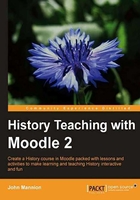
Your first History course
Where to start? The best place is with a scheme of work for a particular year group. Start by building one course and acquiring particular skills. This will inevitably lead on to creating other courses so that those skills can be enhanced and utilized with other year groups.
Key stage 3 courses (11 — 13 year olds)
We are going to create a course for a Year 7 group using a list of key questions, which a teacher might plan to cover in a year. Using this format, it is possible to create a course that has the appropriate structure. For example the Year 7 course might cover the following questions over the academic year:
- Why did William win the Battle of Hastings?
- What did medieval people believe?
- What was life like for medieval peasants?
- What was the impact of the Black Death?
- Why did the peasants revolt in 1381?
- Who was the best king: Henry II, Richard I, or John?
- How did castles work?
- How did explorers discover the rest of the world?

Schemes of work such as this lend themselves to the creation of a single course. Students tend to like the fact that everything they have covered in the year can be found under one roof and they appreciate the benefits to their revision. They have their exercise books to revise from but the course also provides them with the opportunity to revisit quizzes, video clips, slides that reinforce their understanding, and wikis that demonstrate how to answer particular types of questions effectively.
All the topics for the year will be placed in this course. Students will develop their essay writing skills with the emphasis on style and use of their own knowledge. We can use Moodle to highlight and evaluate examples of good practice in a workshop. Students will also work with sources and evaluate their usefulness. As with a book, the resources will be kept in one place but unlike a book the variety of sources that can be used is much more varied and extensive. A collaborative wiki can be set up so that students learn to empathize with medieval peasants or monks. We can use the book module to ensure that any notes about a particular topic are easily accessible. We can set up links to other sites so that independent learners can pursue their own line of enquiry. The series of eight questions create logical sections within our course. During the course, specific tasks and activities will be assessed such as the essay, sources exercises, and quizzes. The gradebook will record student performance. Marking and feedback will be provided in line with the institution's marking policy.
Key stage 4 courses (14 — 16 year olds)
A slightly different approach is required with Key Stage 4 courses. The modular approach, tackling different skills in examination papers necessitates the creation of a series of separate courses for History GCSE classes. The Divided Union paper concentrates on skills such as source evaluation and the ability to answer questions of a distinct nature. Obviously, to answer effectively requires the background knowledge to the McCarthy period and the Civil Rights movement. Such a course would concentrate on teaching how to write model answers as well as reinforcing students' understanding of important content and issues. Students will find in the course an array of learning materials to ensure good background knowledge such as quizzes, lessons, flashcards, and so on and practice in the writing and evaluating of good quality answers to questions.
The Germany 1918-1939 paper requires an in-depth knowledge and the ability to write good answers to causation questions. A good course helps to signpost strong technique and prepare students thoroughly for the examination so that when they come to sit the paper, there are no surprises. The skills are different within the courses and the courses reflect the differences.
Students at this key stage are able to cope with a greater number of courses in their subject. In History, they also appreciate that the series of questions allows them to breakdown and learn the content and the different techniques required to achieve the higher grades. If they want to work on their ability to answer causation questions then a good course will have clear signposts to the differences between a Level 1, 2, and 3 answer (use a wiki), quizzes, flashcards, notes, and so on to cover key content (examples in each course section), and opportunities to submit answers to workshops and to teaching staff.
There are clear differences between courses at Years 7 and 8 compared to Years 10 and 11. Moodle caters for the difference in needs and the concentration on content or a skills-based approach. Teachers will recognize and share these aspirations. Moodle enhances the way teachers do it at the moment. The Moodle course is another vital component to success alongside the exercise book and folder, the lever arch file, and the textbook.